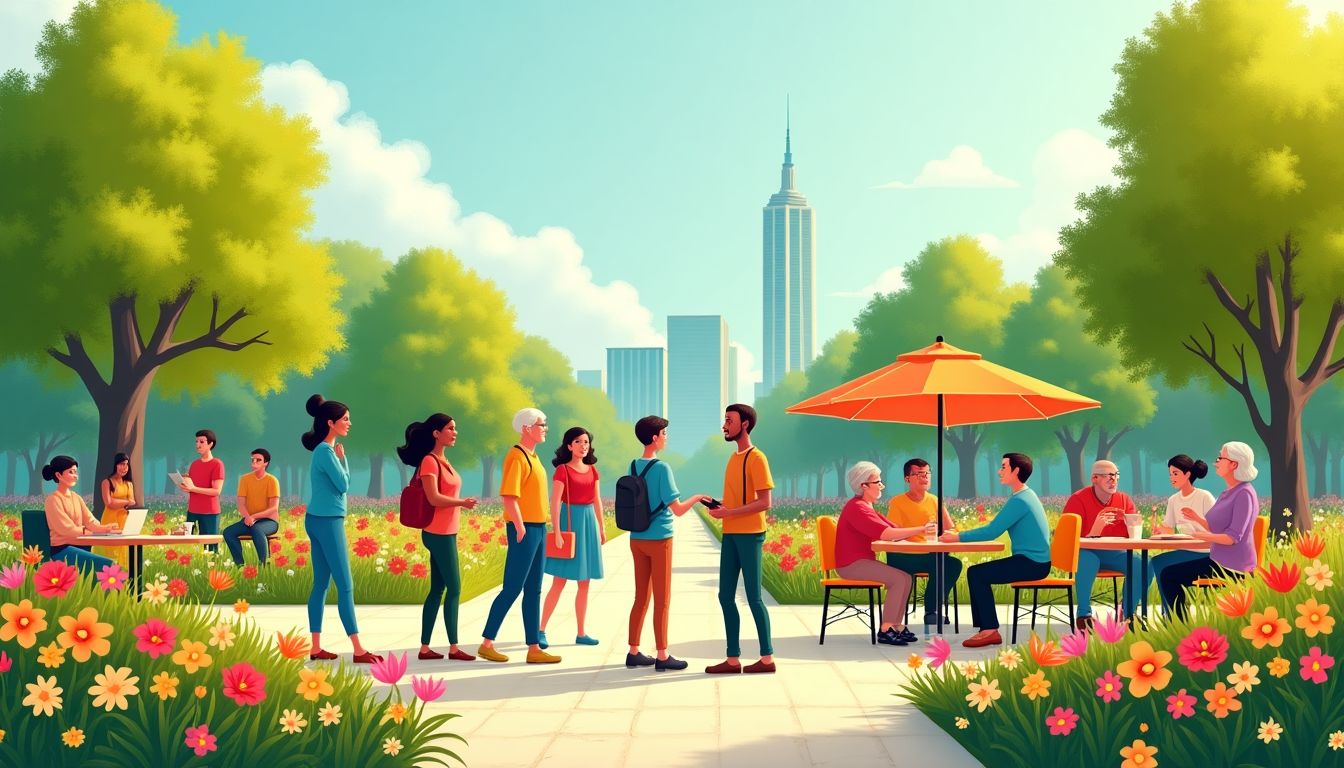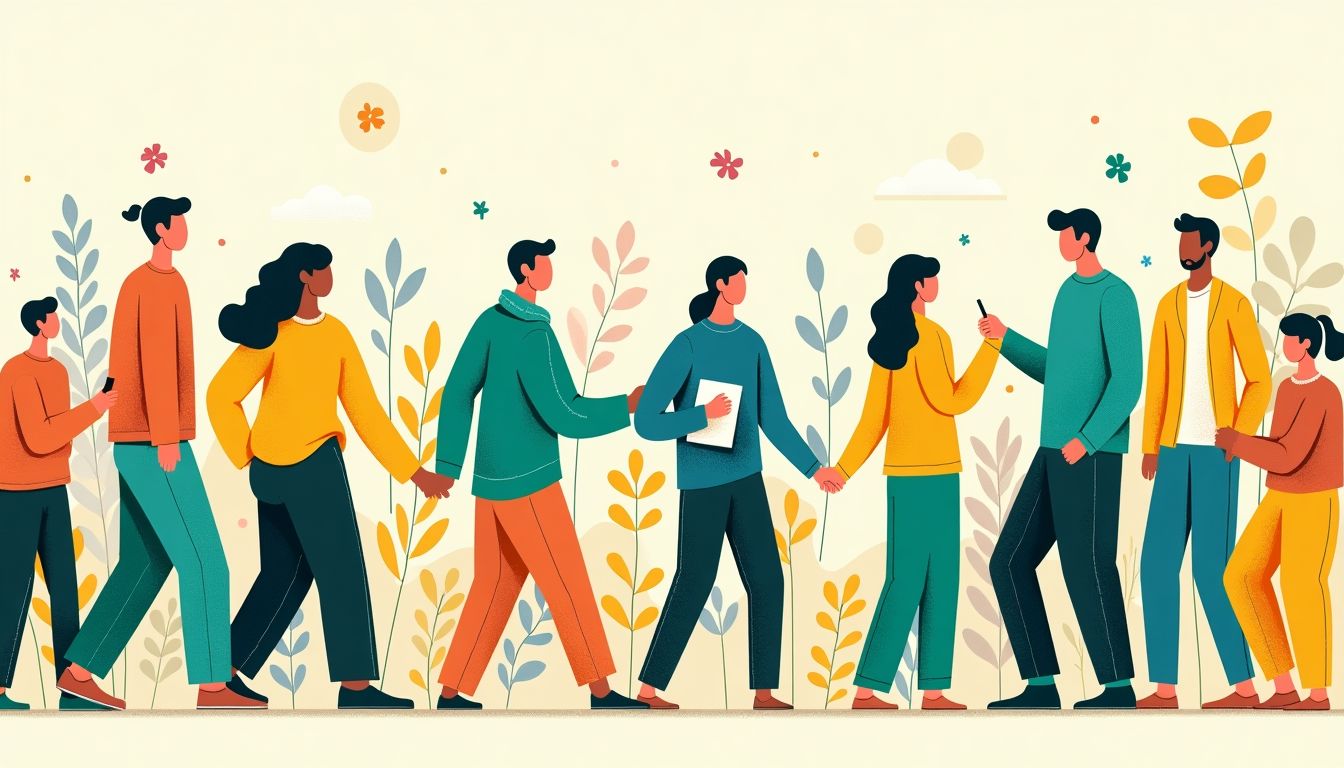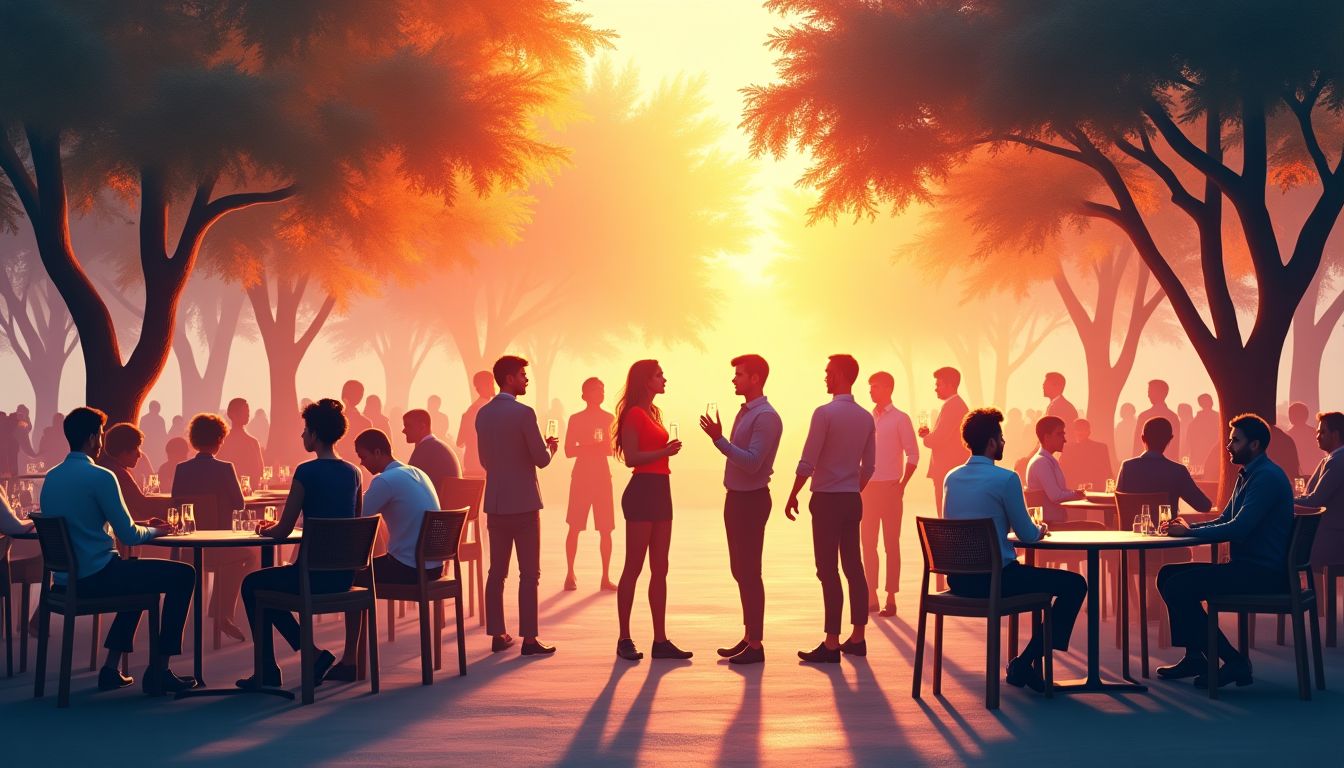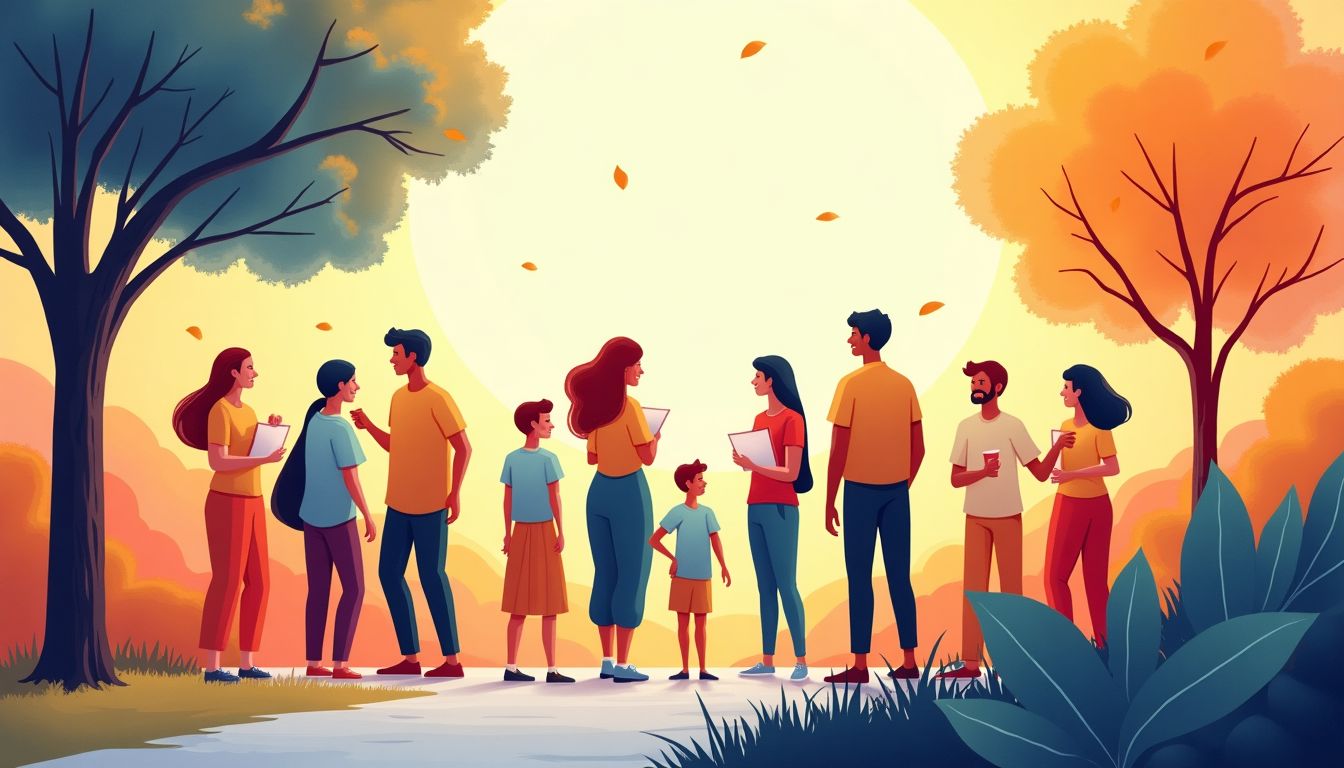Introduction: The Foundation of Togetherness
The only thing we have to fear is fear itself. – Franklin D. Roosevelt. This powerful quote highlights how fear can hinder our progress and prevent us from embracing new opportunities. In a world where traditional job roles are vanishing faster than socks in a dryer, the fear of an uncertain future looms large. As automation and Artificial Intelligence change the landscape of work, we must ponder an unsettling question: What happens to our sense of community when economic roles become obsolete? This inquiry compels us to look beyond productivity and consider what truly matters to us as social beings.
What if the void left by disappearing jobs could be filled with opportunities for deeper connections and shared experiences instead of merely a sense of loss? With the ever-evolving nature of our work lives, creative minds like Aristotle, Jane Goodall, and Marie Curie remind us that community can thrive outside the constraints of economic labels. As we navigate this transition, we stand at the brink of redefining togetherness. Can we shift our focus from what we do to who we are? Can vibrant lives blossom from the ashes of traditional employment? Join us as we explore this compelling journey into the essence of community.
1. Embracing New Identities in the Absence of Work
As conventional roles based on employment fade, individuals might find themselves grappling with their identities. Have you ever met someone who leads with their job title like it’s a badge of honor? “Hi, I’m John, a Senior Vice President of Widget Manufacturing.” But what happens when that title disappears, leaving John to wonder who he is beyond the corner office and the fancy business cards? This section will examine the psychological impacts of losing work as a cultural cornerstone:
1.1 Understanding Identity Beyond Profession
In a society often defined by our jobs, we frequently tie our self-worth to our professions. A sudden shift can lead to an identity crisis, prompting us to re-evaluate who we are at our core. Let’s discover how removing the employment cloak can allow for a richer understanding of the self. Imagine John now introducing himself as a “poet” or “weekend gardener.” Who knows? Making sourdough bread might be his hidden talent!
1.2 Psychological Ramifications of Job Loss
Job loss can unleash a wave of emotions—grief, anger, or even a sense of release! Research has shown that losing a job can lead to issues like anxiety and depression. Yet, with time, many individuals also discover resilience and new paths. Let’s face it: without the daily grind, you might actually find time for that Netflix series everyone’s been raving about!
1.3 New Social Constructs and Self-Identification
With work no longer at the forefront of our lives, we can explore alternative social constructs that define our interactions. Perhaps we’ll start identifying ourselves by our hobbies, passions, or even our magical ability to bake the best brownies on the block. Community may reemerge not from corporate ladders but through shared experiences!
1.4 Case Studies on Communities Reinventing Identity
Take a look at staunch examples of communities that have reinvented themselves in the face of change. From thriving artists’ collectives to volunteer organizations reimagining their role in society, success stories abound. These groups exemplify how new identities can foster a sense of belonging that transcends traditional work roles—like a quilt made from scraps of fabric, each piece telling a unique story.
2. Cultivating Shared Experiences as a Community Bond
A shift from workforce productivity to collectively enjoyed experiences could redefine what community means. When we engage in fun, shared activities, we create bonds that go beyond just talking about the weather or the latest binge-worthy show. Let's explore various ways shared experiences might bond individuals:
2.1 Importance of Common Interests
Ever notice how quickly a conversation flows when you and your friend discover you both love pizza? Finding common ground is like unlocking a door to a new friendship! Shared interests help paint the picture of community, where everyone feels included and valued. Whether it's a love for sports, art, or gardening, these interests are the threads that weave us together. Remember when the NBA created a fusion of music, art, and basketball at the All-Star Game? That vibe brought together fans from all walks of life.
2.2 Events and Festivals as Community Catalysts
What’s better than free food? Free food at a Texas State Fair or a local festival! These events aren't just about fun; they're powerful catalysts for community bonding. From music festivals to local art fairs, these gatherings create a buzz. People laugh, share stories, and make memories together. It’s like that time your local community set up an outdoor movie night where everyone brought a snack to share. You know you’re in a good place when someone offers you their homemade popcorn recipe!
2.3 Case Studies on Successful Community Engagements
Let’s take a peek at some communities that have really hit it out of the park when it comes to shared experiences. In West Seattle, local residents regularly host “Community Dinners,” where everyone brings a dish. This has not only fueled people’s stomachs but also friendships! In New York City, the NYC Parks department holds various events like outdoor yoga sessions in parks, which not only help people relax but also build bonds. Who knew downward dog could bond a community?
2.4 The Role of Technology in Facilitating Experiences
Ah technology, you delightful enigma! While we often think of it as a barrier to connection, it can actually enhance our shared experiences. Platforms like Meetup or Eventbrite help bring people together around common interests, from hiking in the woods to brunching with mimosas. These platforms create virtual spaces for individuals to come together physically. So, the next time you see a bacon festival popping up nearby, don’t just scroll past—join in and connect with fellow bacon lovers!
3. Rediscovering Locality: The Community Space Revolution
As society transitions from economic productivity, the physical spaces we inhabit take on new significance. Traditional offices might be fading, but what about parks, co-working spaces, and community gardens? Let’s delve into how these community spaces can be reimagined for a post-work existence:
3.1 Parks as Community Hubs
Parks are like the backyard of our cities/ communities. Imagine families gathering for picnics, children playing tag, and yoga classes filling up the air with calmness amidst the hustle. When we design parks better, we create spaces that foster community interaction. Take what National Park Service suggests—designing parks that focus on accessibility allows more people to enjoy and create conditions that promote collaboration and friendship!
3.2 The Rise of Co-Working Spaces and Cafés
Remember when work was only defined by cubicles? Well, now you can work from cozy cafes or even at a popular co-working space like WeWork, where the coffee is just as meaningful as the collaboration that happens. These spaces encourage interactions that go beyond meetings—like the budding friendships formed over that extra shot of espresso! They foster creativity and a sense of belonging that transforms work into fun, meaningful connections.
3.3 Innovations in Local Architecture and Urban Planning
Innovation is not just for tech; it’s for how we build our spaces too. By planning innovative community spaces, we can cultivate interactions. Look at ArchDaily which showcases projects that turn buildings into community hubs. When architecture encourages social gatherings, we create environments where folks can reconnect, enhancing community identity.
3.4 Community Gardens and the Sustainability Movement
Who knew digging in the dirt could foster relationships? Community gardens are popping up in towns everywhere, and for a good reason. They not only yield fresh veggies but also grow friendships and teamwork. Local green thumbs share their secrets and knowledge, bringing people together for a common goal: to cultivate flourishing spaces! Just look at American Community Garden Association for inspiration on how these gardens are the plants that bond neighborhoods.
4. Generational Wisdom: The Role of Elders in Community Rebuilding
Elders are often seen as the guiding light in our communities, holding a treasure trove of knowledge and life experiences. As we navigate the complexities of rebuilding communities in a post-work world, elders can play a significant role in sharing their wisdom and shaping our future. They can help us connect the dots between the past and the present, teaching us about values, traditions, and the importance of relationships. But how can we ensure that their voices are heard and integrated into the fabric of our new communal structures?
4.1 The Importance of Elders in Societal Narratives
Elders have walked the path we’re all on, often weathering storms that shape our understanding of life, work, and community. Their narratives provide context and depth that can guide us through challenging times. Here are some reasons why their presence is vital:
- Historical Perspective: Elders can share stories of past struggles and triumphs, offering valuable lessons.
- Emotional Support: Their life experience equips them to provide empathetic listening and guidance.
- Cultural Transmission: Elders often hold the key to maintaining community traditions and values.
4.2 Programs Designed to Facilitate Intergenerational Interaction
To foster relationships between elders and younger members of the community, various programs have been initiated successfully. These programs aim to break down age barriers and encourage collaboration. Some examples include:
- Mentorship Programs: Matching elders with younger individuals for guidance in personal development and career paths.
- Storytelling Events: Organizing gatherings where elders share their life stories, fostering deeper connections through shared experiences.
- Community Workshops: Creating opportunities for elders to teach skills, like gardening or crafts, to younger generations.
4.3 Case Studies on Successful Elder Engagement Models
Let’s look at a couple of effective models that have made significant strides in engaging elders within communities. One notable example is Generations United, an organization dedicated to promoting intergenerational collaboration across the United States. Their initiatives include:
- Research and Advocacy: Supporting policies that benefit older adults and younger generations.
- Program Development: Offering support to communities to structure intergenerational programs.
Another example is the Senior Scene initiative, which fosters connections through shared social activities and cultural events, promoting a sense of purpose among older adults.
4.4 Benefits of Wisdom Sharing in a Knowledge Economy
In our rapidly changing world, tapping into the wisdom of elders can provide stability and insight that enhances community resilience. The benefits are expansive:
- Enhanced Problem-Solving: Experience often breeds creative solutions.
- Stronger Community Bonds: Building relationships between generations fosters unity.
- Preservation of Culture: Wisdom-sharing helps maintain cultural narratives that keep communities grounded.
5. The Power of Volunteerism: Reimagining Contribution
As work dynamics change, volunteerism becomes a critical avenue for individuals to find purpose and contribute to their communities. By stepping into volunteer roles, people can transform their desire for connection into meaningful action. Volunteering not only fills the gap left by traditional jobs but also strengthens community ties and fosters collaboration.
5.1 Motivations Behind Volunteerism
So why do people volunteer? The motivations can be as varied as the individuals themselves. Here are some common driving forces:
- Desire to Help: Many find fulfillment in supporting others and giving back.
- Social Connections: Volunteering can lead to new friendships and a sense of belonging.
- Skill Development: Volunteers gain valuable skills that can enhance their personal and professional lives.
5.2 Link Between Volunteering and Mental Health
Engaging in volunteer work positively impacts mental health in numerous ways:
- Reduced Stress: Helping others can divert attention from personal problems, leading to lower stress levels.
- Improved Mood: Acts of kindness trigger the release of endorphins, generating the so-called “helper’s high.”
- Sense of Achievement: Making tangible contributions fosters a sense of purpose.
5.3 Structures and Platforms for Volunteering
As communities embrace volunteering, various platforms facilitate these efforts. Here are some effective structures:
- Online Volunteer Matching Services: Websites like VolunteerMatch connect individuals with organizations looking for volunteers.
- Local Volunteer Hubs: Establishing community centers where individuals can learn about local opportunities.
- Corporate Volunteer Programs: Encouraging companies to allow employees to take paid time off for volunteer work strengthens community relationships.
5.4 Case Studies of Impactful Volunteer-driven Communities
Communities around the world have witnessed transformative changes through the power of volunteerism. One impressive example is the Rebuilding Exchange in Chicago. This organization taps into the collective power of hundreds of volunteers each year, engaging them in sustainable building projects and community-focused initiatives. By getting involved, volunteers not only help their communities but also gain valuable skills and experience.
Another example can be found in AmeriCorps, a U.S. government program that encourages citizens to work on important community issues. Volunteers build houses, mentor youth, and provide essential services to thousands of communities across America.
6. AI Solutions: How Would AI Tackle This Issue?
In a world where traditional jobs diminish, Artificial Intelligence (AI) could become a powerful ally in rebuilding communities. The right AI solutions can facilitate deeper community engagement, better understand local needs, and promote shared experiences. Here's how AI can serve as a transformative force in this endeavor:
6.1 Potential of AI in Community Engagement
AI can change the way communities connect and collaborate. By leveraging artificial intelligence, communities can organize events, share resources, and initiate discussions tailored to their residents' interests. AI tools can analyze social media trends and local data, identifying what activities resonate with community members.
6.2 Using Data Analytics to Understand Community Needs
Through data analytics, communities can gain valuable insights into their members' preferences and challenges. By utilizing platforms like Google Analytics, community leaders can track engagement and tailor initiatives to meet the evolving needs of their citizens. Everything from local traffic patterns to survey responses can inform decision-making and resource allocation.
6.3 AI-driven Platforms to Foster Community Connections
We are seeing a rise in AI-driven apps designed to connect people within neighborhoods. Consider platforms like Meetup that already organize social groups; combining such technology with AI can enhance recommendations and serve up personalized suggestions for events based on community engagement levels. Imagine receiving personalized alerts for local activities that resonate with your interests—it's a great way to foster connections!
6.4 Developing AI Tools for Sustainable Communication
AI has the potential to streamline communication channels within communities. For example, an AI-driven chatbot could address common questions quickly, helping engage new residents and promote events. Organizations like Closest are exploring ways communities can implement chatbots, paving the way for constant, accessible updates and interactions among members.
6.5 Creating Virtual Experiences to Enhance Community Bonds
AI can also enable virtual experiences that unite communities. Platforms such as Twitch or Discord offer unique opportunities for virtual gatherings. By harnessing AI, these platforms could create tailored content delivery, allowing for the development of interactive storytelling or community forums that respond to residents' interests and facilitate real-time collaboration.
Actions Schedule/Roadmap (Day 1 to Year 2)
This roadmap serves as a structured approach for organizations or government entities looking to harness AI solutions to enhance community interactions and rebuild social connections:
Day 1: Assemble a multi-disciplinary task force consisting of community leaders, data analysts, AI experts, and local volunteers to establish objectives.
Day 2: Launch a community survey utilizing online tools to gather insights on interests, concerns, and technological literacy.
Day 3: Set up an online forum or app for ongoing communication among members, incorporating AI analytics to understand engagement levels and preferences.
Week 1: Partner with local tech organizations to explore AI solutions that can facilitate events, communication, and customized recommendations.
Week 2: Develop a pilot program utilizing chatbots for answering frequently asked questions within the community forum and gathering feedback.
Week 3: Conduct workshops to educate residents on using local AI-driven tools, showcasing platforms for enhancing community engagement.
Month 1: Host a community event to demonstrate AI applications, encouraging discussions on how these technologies can benefit the population.
Month 2: Initiate a virtual storytelling campaign powered by AI analysis, showcasing community members' narratives through curated online events.
Month 3: Collect data on user interactions and collect feedback to refine the AI tools and platforms available to the community.
Year 1: Implement educational programs in schools centered on technology literacy and its applications for improving community ties.
Year 1.5: Launch a community-wide festival celebrating innovative AI applications and their impact on local engagement, attracting experts and enthusiasts from around the country.
Year 2: Conduct a comprehensive review of community impacts and areas of growth while adjusting technology initiatives and goals based on residents' feedback.
Conclusion: A New Dawn for Community
As we embark on this transformative journey into a post-work world, it’s time to rethink what it means to belong. By shifting away from the traditional markers of identity that tie us to our jobs, we can sculpt a rich mosaic of community life filled with shared passions, collaborative experiences, and strengthened bonds. The potential for vibrant neighborhoods built around creativity and connection rests within our reach—if we're willing to embrace change and innovate together. The challenges will not be easy, but as we look at the opportunities ahead, we can take control of our narratives and weave new identities for ourselves and our communities with purpose. How will you engage with your community now? What role do you see technology playing in your future interactions? Share your thoughts in the comments below, and let’s continue this important conversation!
FAQ
Q1: What does community mean in today's world?
A1: A community is a group of people who share common interests, values, or experiences. In our changing world, communities aren't just about where you live; they're also about the relationships you build and the shared activities you engage in. Think of your neighborhood, your online group, or even school clubs as community examples. These connections give us a sense of belonging and support, which is more important than ever.
Q2: Why is it essential to rethink our identity without traditional work?
A2: Many of us have tied our identities to our jobs; for instance, we often introduce ourselves by saying what we do. But if work disappears or changes drastically, we need to figure out who we are beyond our job titles. Finding new passions or roles in the community can help maintain a sense of identity and purpose. By shifting focus to hobbies and personal interests, we might discover a more fulfilling way to view ourselves.
Q3: How can we stay connected in a world where work is less central?
A3: Shared experiences can help us connect. This could be through participating in community events, volunteering, joining clubs or workshops, or even just enjoying time in local parks. The goal is to find and nurture connections outside of work. By engaging in activities we love, we can meet people who share our interests, making community feel more vibrant and alive. So why not check out local events in your area? Visit [Eventbrite](https://www.eventbrite.com/) for ideas!
Q4: What role do seniors play in rebuilding community?
A4: Elders have a wealth of wisdom and stories that can enrich our community relationships. They can guide younger generations, share life experiences, and even help shape community programs. Programs aimed at intergenerational interactions, like mentoring or storytelling, can bridge the gap and foster meaningful connections. If you're interested in learning about one such program, check out the [Generations United](https://www.gu.org/) website.
Q5: How does volunteering contribute to community rebuilding?
A5: Volunteering is a powerful way to make a difference. When we give our time and skills to help others, we create bonds with fellow volunteers and those we help. Research shows that volunteering can boost your mental health, strengthen social ties, and significantly improve community spirit. Organizations like [VolunteerMatch](https://www.volunteermatch.org/) can connect you to local opportunities where you can make an impact.
Q6: How can technology help in redefining communities?
A6: Technology has the potential to connect us in innovative ways. From social media platforms that help form online groups to apps designed for organizing events, technology makes it easier to bond and engage with others. For example, platforms like [Meetup](https://www.meetup.com/) allow you to find local groups that share your interests, making community building more accessible. Think about how we used video meetings during tough times; tech can bring us together even when we're apart!
Q7: How can we take the first steps toward building a stronger community?
A7: Start with conversations! Talk to your neighbors or friends about shared interests or ideas for activities. You can organize meet-ups, brainstorming sessions, or focus groups to find out what everyone wants. Even creating a community message board online or in your neighborhood can spark ideas and bring people together. Remember, small steps can lead to big changes!
Q8: What types of events can help foster community bonding?
A8: Here are some ideas for events that can strengthen community connections:
- Local festivals celebrating culture or arts
- Outdoor movie nights in parks
- Workshops focused on skills sharing (like cooking classes or gardening)
- Monthly book clubs or game nights
- Volunteer days for neighborhood improvement
Think creatively about how you can bring people together. The more diverse the events, the more likely you are to connect with different folks in your community!
Q9: How can shared experiences change our community relationships?
A9: Shared experiences can deepen connections by creating memories together. Participating in events, collaborating on projects, or simply spending time in communal spaces allows us to bond over common interests and passions. Research shows that these kinds of interactions lead to improved well-being and satisfaction in life. Simply put, the more we connect, the happier we feel! Check out the resources on [Community Tool Box](https://ctb.ku.edu/en) for tips on building shared experiences.
Q10: What is the future of community in a post-work world?
A10: While the landscape is indeed changing, the future of community looks promising. As we embrace new identities beyond work, focus on shared experiences, and leverage technology for connection, we can create vibrant communities rich in support, creativity, and personal growth. This shift encourages deeper relationships that go beyond mere economic transactions. A united community can offer a sense of belonging that transforms how we live and relate to one another.
Wait! There's more...check out our gripping short story that continues the journey: A Beacon of Resilience
Disclaimer: This article may contain affiliate links. If you click on these links and make a purchase, we may receive a commission at no additional cost to you. Our recommendations and reviews are always independent and objective, aiming to provide you with the best information and resources.
Get Exclusive Stories, Photos, Art & Offers - Subscribe Today!





























Post Comment
You must be logged in to post a comment.